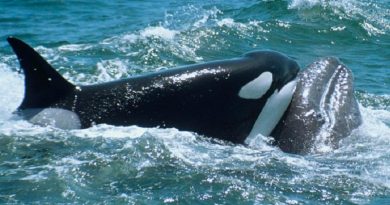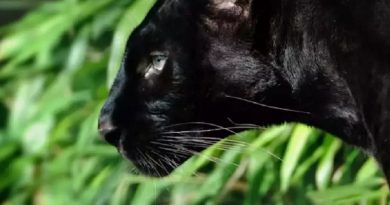Whales Dancing With Dolphins (VIDEO)
Whales dancing with Dolphins.
Baltimore Wildlife tours took a trip 22 km offshore to film the humpback whales lunge feeding and massive pods of dolphins bow riding the boat.
WOW, what a sight!
Baltimore Wildlife tours took us on a unique trip 22km offshore from Baltimore to catch the amazing sight of humpback whales lunge feeding and massive pods of dolphins bow riding the boat.
Video by Dan Linehan
Dan Linehan of the Irish Examiner was on hand to capture some snapshots of the wonderful creatures off Ireland’s coast.
Marine Mammal Biologist, Emer Keaveney also gave us an insight into these fascinating animals.
The big ocean blue covers 70% of the Earth’s surface and harbour some of its most environmentally important regions, providing employment and food security for tens of millions of people.
Yet with ever growing populations and the demand for resources increasing, it’s possible to exploit the ocean’s resources until there are no more resources to exploit.
If you haven’t guessed yet I am a marine biologist and one of many who has been “wild about whales” since before I can remember.
I am a co-founder of Ocean Research and Conservation Ireland (ORCireland), a voluntary organisation that aims to promote awareness and conservation of marine mega-fauna in Irish waters and a whale watch guide aboard Baltimore Wildlife Tours, with skipper/ expert naturalist Kieran Collins.
I am also a member of the Irish Whale and Dolphin Group (IWDG) and Cork Nature Network (CNN). Thanks to these non-profit organizations we are beginning to appreciate the value of Irish biodiversity.
You might think you need to travel all the way to Spain to waterparks, like “Loro Parque” to see dolphins but in-fact, Ireland being an Island nation and surrounded by the sea, has some of the best whale watching in the world, from land or boat.
Irish waters have some of the richest and most diverse marine ecosystems in the North-east Atlantic and provide an important habitat for a diverse array of marine mega-fauna, from Atlantic Blue-fin tuna (Thunnus thynnus) to cetaceans (whales, dolphins and porpoises) and elasmobranchs, (sharks, skates and rays), such as the porbeagle shark (Lamna nasus).
The waters off west Cork, in turn hold some of the highest relative abundances of many species of dolphins, whales, and sharks and can rival anywhere in the world for whale watching and angling.
Along the south coast of Ireland, it is not un-common to encounter amazing marine wildlife. Whales and dolphins which are classified based on their dentation can be seen all year and seasonally found in great abundances.
Baleen whales have keratinized bristles that hang from their upper jaw that allow them to filter feed on tiny forage fish species, such as herring (Harangus harangus) and sand-eel (Ammodytus), while toothed cetaceans, otherwise known as Odontocetes, have teeth that allow them to capture larger prey.
Toothed whales and dolphins in Irish waters include dolphins and porpoise, while larger whales have baleen plates, with the exception of the pilot whale (Globicephala melas), the sperm whale (Physeter macrocephalus) and killer whale (Orcinus orca), who have teeth. Baleen whales such fin whales, can be seen in the waters off west Cork, particularly in the autumn months.
These are the second largest animal on Earth at 22 meters, second only to the Blue Whale, the largest animal to have ever lived. Blue whales have been sighted offshore by the Irish Air Corps for Example, although sightings of those are quite rare.
Whale watching trips on-board “Radiance” are never a disappointment and Friday was no exception. The waters off west Cork were ALIVE!
We were lucky to encounter not one but four to eight humpback whales (Megaptera novaeangliae), countless minke whales (Balaenoptera acutorostrata) and literally hundreds of short-beaked common dolphin (Delphinus delphis). What were they all doing here you might ask? Well they are foraging.
Huge bait balls of tiny fish attract an array of marine wildlife; in addition we have seen a diverse range of seabirds, such as skuas, northern gannets and manx shearwaters in abundance.
Just goes to show that it is important that we protect our marine environment from over exploitation of forage fish species, from plastic noise pollution. When we have healthy ecosystems it shows that we too are healthy and so now more than ever it is time to spread awareness of the wonders of Ireland’s marine territory.
Source: https://www.youtube.com/watch?v=eYNTuOsQPco
You may also like:
==> 45 L I F E H A C K S F O R W O M E N T H A T A R E A C T U A L L Y G E N I U S (V I D E O)
==> 3 0 S E C R E T H A C K S T O M A K E Y O U A N I N S T A G R A M S T A R (V I D E O)
==> 45 L I F E H A C K S T H A T M A Y S A V E Y O U R L I F E ( V I D E O )
==> These Sewing Hacks Are Cooler Than They InSEAM! DIY Ideas and Hacks by Blossom (VIDEO)


